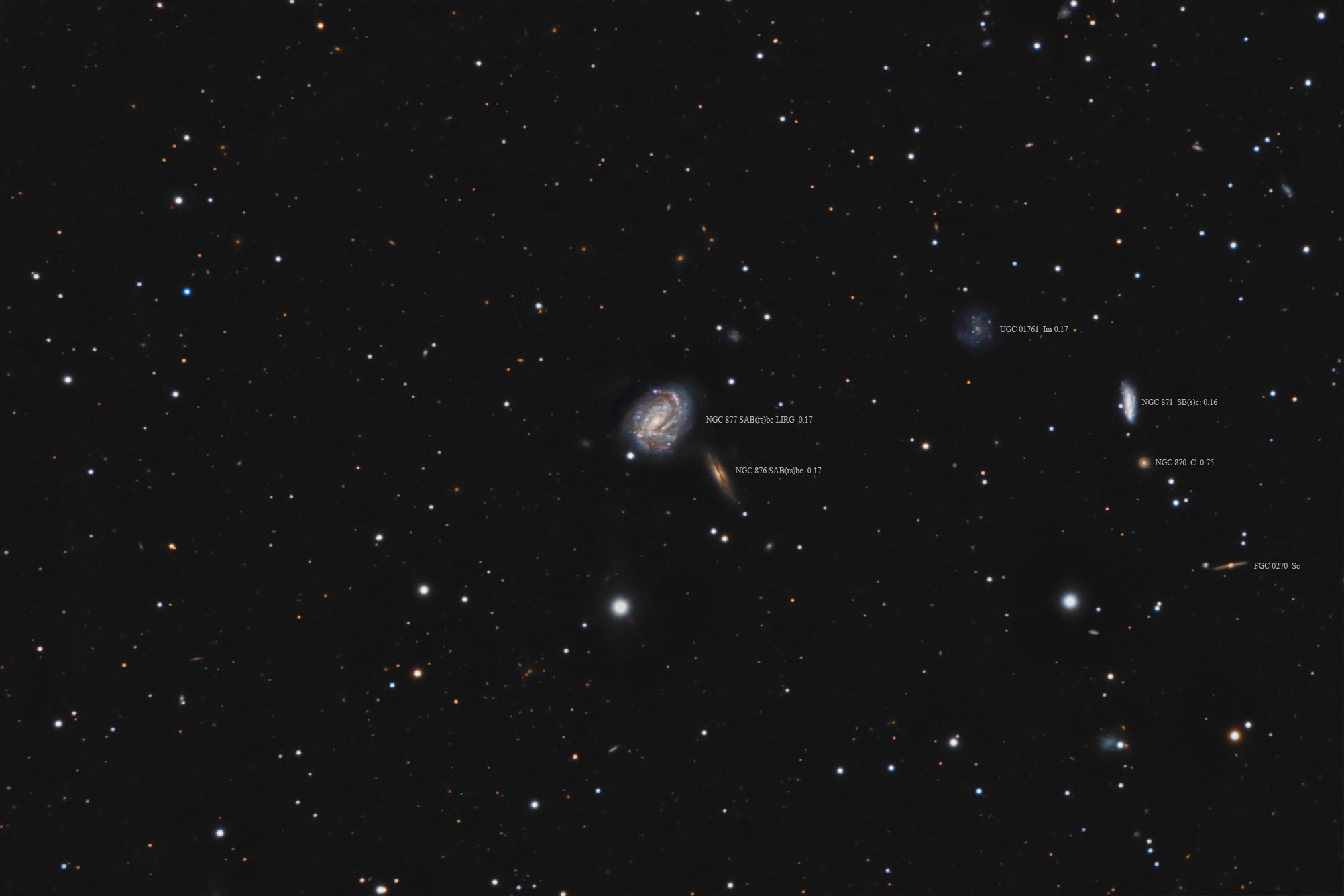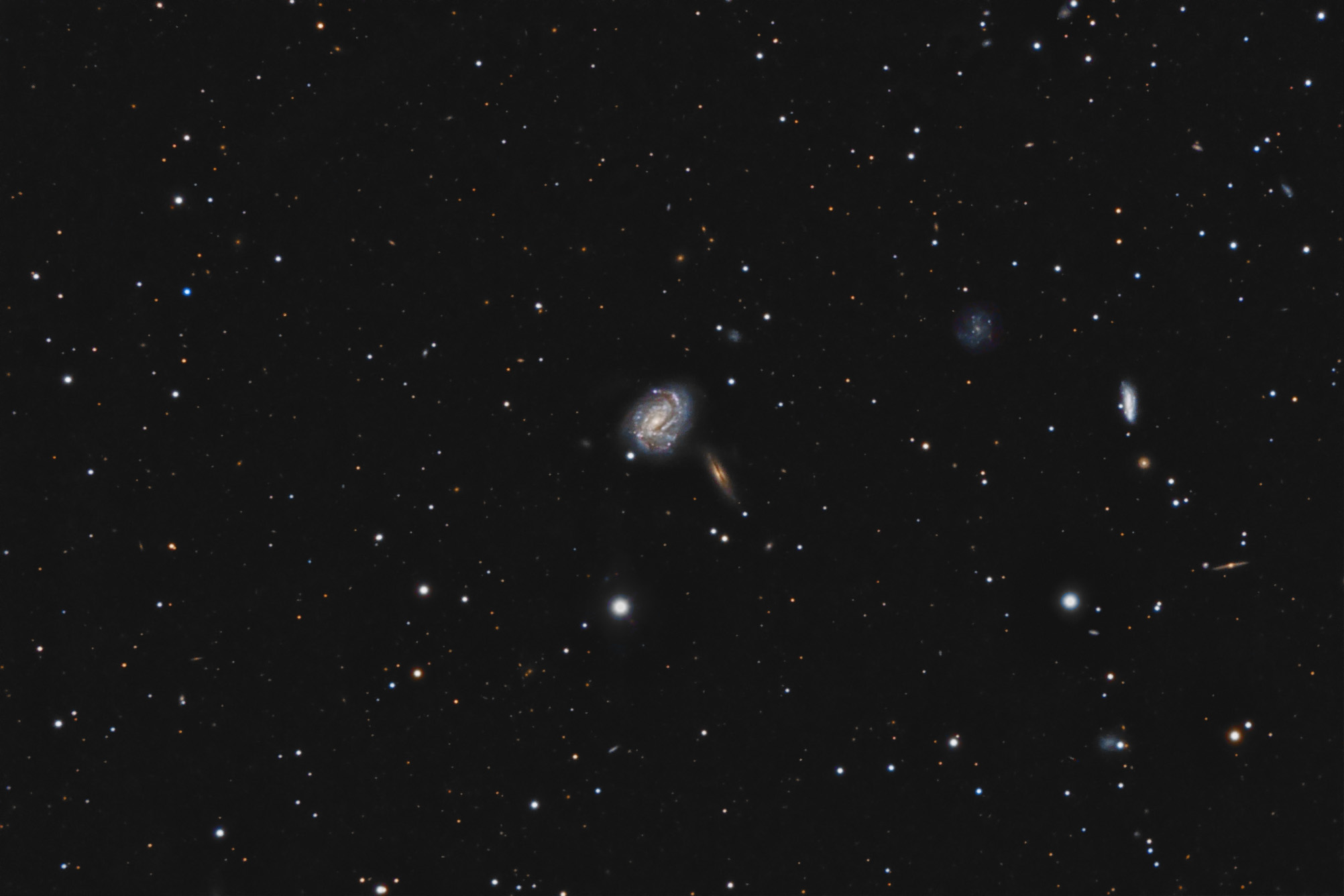| Description | Images |
Object name: NGC0877Designation(s): NGC0877, NGC0870, NGC0871, NGC0876, NGC 877 is a barred spiral galaxy in Aries about 170 million light-years from us. Tully Fisher measurements closely agree ranging from 150 to 180 with 170 being the median value. While I found little on it I think it quite possibly interacting with NGC 876 or at least it has interacted with some other galaxy as it has a faint plume to the northeast that curves around somewhat following the shape of the galaxy. It has a plume to the east off the southeastern end of the galaxy that appears to run right by the northeast edge of NGC 876's disk possibly covering it up. It ends in a puff to the northwest of NGC 876's core. While I've seen NGC 877 described as a grand design spiral it looks far too messed up for that classification to me. Its arms are mostly just arm segments that have no order to them. A major one runs from the west side of the core up and over the north end of the galaxy yet isn't connected to the core, bar or anything that I can see. An arm segment below its start is rather linear and made up mostly of knots. The edges of the arms along dust lanes show quite a bit of H alpha pink in my image indicating a lot of star formation is going on in these areas. Another indication of possible recent interaction. Also, note the designation of LIRG in its classification. That stands for Luminous Infra Red Galaxy. This usually is caused by dust heated by massive star formation. It was discovered by William Herschel on October 14, 1784. It isn't in either H400 program Related Designation(s):2MASS J02170922+1431230, 2MASS J02171074+1432523, 2MASS J02171075+1432487, 2MASS J02175318+1431161, 2MASS J02175327+1431185, 2MASS J02175963+1432384, 2MASX J02170921+1431231, 2MASX J02171073+1432521, 2MASX J02175332+1431179, 2MASX J02175963+1432387, 2MASXi J0217092+143123, 2MASXi J0217107+143252, 2MASXi J0217532+143117, 2MASXi J0217593+143243, 87GB 021516.2+141835, 87GB[BWE91] 0215+1418, AKARI J0217108+143255, AKARI J0217596+143239, CGCG 0214.4+1419, CGCG 0215.2+1419, CGCG 438-046, CGCG 438-052, GALEXASC J021709.32+143123.0 , GALEXASC J021710.64+143252.6 , GALEXMSC J021709.27+143122.9 , GALEXMSC J021710.62+143252.2 , HDCE 0130 NED001, HDCE 0130 NED002, HDCE 0130 NED003, IRAS 02144+1419, IRAS 02152+1418, IRAS F02144+1419, IRAS F02152+1418, LCSB L0106N, LDCE 0158 NED001, LDCE 0158 NED002, LDCE 0158 NED003, LGG 053:[G93] 002, LGG 053:[G93] 004, LGG 053:[G93] 005, MCG +02-06-052, MCG +02-06-053, MCG +02-06-057, MCG +02-06-058, NGC 0870, NGC 0871, NGC 0876, NGC 0877, NGC 0877 N, NGC 0877 S, NGC 0877:[KCP2006] 1, NGC 0877N, NGC 0877S, NGC0870, NGC0871, NGC0876, NGC0877, NVSS J021710+143251, NVSS J021753+143115, NVSS J021759+143237, PGC 008721, PGC 008722, PGC 008770, PGC 008775, SSTSL2 J021753.22+143117.9, UGC 01759, UGC 01766, UGC 01768, UZC J021710.7+143252, UZC J021759.4+143240, UZC-BGP 09A, UZC-BGP 09B, [M98j] 037 NED01, [M98j] 037 NED02, [PVK2003] J034.29375+14.54889 , [RHM2006] LIRGs 006, [WGB2006] 021424+14190_a, [WGB2006] 021424+14190_b, [WGB2006] 021512+14190_a, [WGB2006] 021512+14190_b, |

